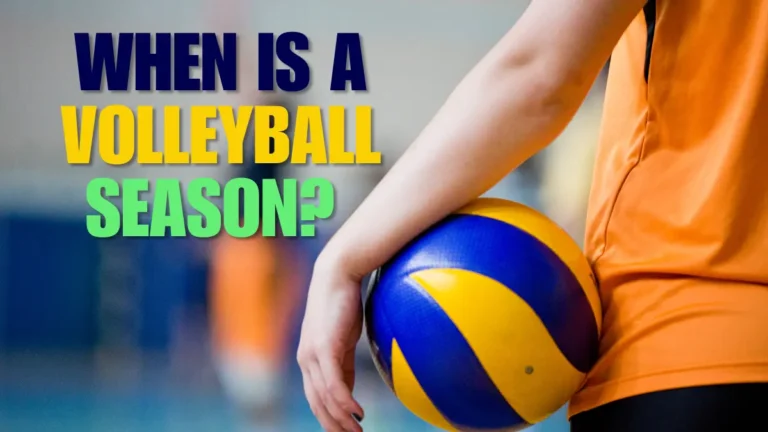What is a Set in Volleyball? Essential Guide & Tips

While introducing my juniors to different volleyball terms. When I explained “set”, many players misunderstood it. Why? Obviously, it was a new term for them and used differently in daily life.
The setting is crucial to create scoring opportunities. It’s typically the second touch after receiving the serve or an attack. The setter aims to position the ball perfectly for attackers.
But this alone isn’t enough. There are many types of sets and ways to play them. If you’re new to the game and don’t know what a set is in volleyball, why it’s essential, and how to do it well, let’s discuss it in detail.
What is a Set in Volleyball?
As I described above, a volleyball set is the ball’s second touch after it crosses the net. It’s usually done by a player called the setter. The setter tosses the ball in the air so another team player can hit it over the net. This hit is called a spike or an attack.
The set is crucial to volleyball because it helps the team create a strong attack. A good set makes scoring a point easier for the attacking player.
Why is Setting Important in Volleyball?
Setting forms the backbone of a team’s offensive play and decides the quality of the spike. It is important in volleyball for several reasons:
Let’s look at each of these reasons in more detail.
Creating Scoring Chances
A well-placed set gives the hitters the best chance to score a point. The setter tries to put the ball in a spot where the attacker can hit it hard and accurately. This ultimately makes the ball nearly impossible to dig.
Controlling the Game’s Pace
The setter can speed up or slow down the game by choosing different types of sets. This helps keep the other team guessing and can make it harder for them to defend.
Tricking the Other Team
A skilled setter can fake out the opposing team by looking one way but setting the ball in another direction. This can confuse the blockers and make it easier for the attacking team to score.
Bringing the Team Together
Setting requires good communication and teamwork. The setter needs to know where their teammates are and what kind of set they prefer. This helps the team play better together.
How to Do a Basic Set in Volleyball?
Now that we know why setting is important, let’s learn how to do a basic set:
- Stand under the ball with your feet shoulder-width apart
- Bend your knees slightly
- Hold your hands four to six inches above your forehead, forming a triangle with your thumbs and index fingers.
- As the ball comes down, push up with your legs and hands
- Contact the ball with your fingertips, not your palms
- Follow through by extending your arms upward
Remember, practice makes perfect! It takes time to become a good setter, so don’t get discouraged if you don’t get it right away.
Different Types of Sets in Volleyball
Setting in volleyball isn’t a one-size-fits-all technique. There are various types of sets, each serving a specific purpose in gameplay. Let’s explore the different types of sets used in volleyball

Front Set
This is the most basic type of set. The setter faces the direction they want to set the ball and pushes it forward with both hands.
Jump Set
The setter jumps before setting the ball. This can help them reach higher balls and set them up more quickly.
Back Set
In a back set, the setter pushes the ball behind them. This is harder than a front set but can be very effective in tricking the other team.
One-Handed Set
Sometimes, the setter might need to use only one hand to set the ball. This is normally done when the ball is far from the setter’s body.
Dump
A dump is when the setter pretends to set but instead hits the ball over the net. Dump by the setter surprises the opponent team and scores a quick point.

Tips to Improve Your Setting Skills
Becoming a skilled setter takes practice and dedication. You can enhance your setting capabilities significantly by adopting the right technique. Some valuable tips to improve your setting skills are:
Common Mistakes to Avoid When Setting
Even experienced players can make mistakes when setting. Recognizing these errors is the first step towards improving your setting technique. Let’s examine some common mistakes to avoid when setting in volleyball.
By avoiding these mistakes, you’ll become a more reliable setter and help your team play better.
The Role of the Setter in Volleyball
The setter is often called the “quarterback” of the volleyball team. They have a big job:
A good setter needs to be smart, quick-thinking, and able to stay calm under pressure. They also need to know their teammates well and understand their strengths and weaknesses.
Setting Drills to Try
Improving your setting skills requires consistent practice. Specific drills can help you refine your technique and build muscle memory. Some drills you can try to improve your setting skills:
Remember to start slow and focus on good technique before trying to set faster or farther. You watch the videos for a detailed guide.
Wrapping it Up
Setting is a key skill in volleyball that can make a big difference in how well a team plays. It requires good hand-eye coordination, quick thinking, and lots of practice. By understanding what a set is, why it’s important, and how to do it well, you’ll be on your way to becoming a valuable player on your volleyball team.
Whether you’re just starting out or looking to improve your game, focusing on your setting skills can help you become a better all-around volleyball player. So get out there, practice your sets, and have fun playing this great sport!
Frequently Asked Questions
Can any player on the team set the ball?
Yes, any player can set. However, teams usually have a designated setter who specializes in this skill. Other players may set if the setter can’t reach the ball.
Is it legal to set the ball over the net?
Yes, it’s legal to set the ball over the net. This is called a “dump” or “setter dump.” The setter must not touch the net or cross the center line when doing this.
How can I tell if I’m setting the ball legally?
A legal set should be a quick, clean contact. The ball shouldn’t rest on your hands, should be contacted simultaneously by both hands, and shouldn’t spin. Your hands should form a triangle shape.
How long does it take to become a good setter?
Basic technique can be learned in a few weeks or months. However, becoming a great setter takes years of practice to develop game-reading skills, understanding teammates, and making quick decisions under pressure.





